Paper Menu >>
Journal Menu >>
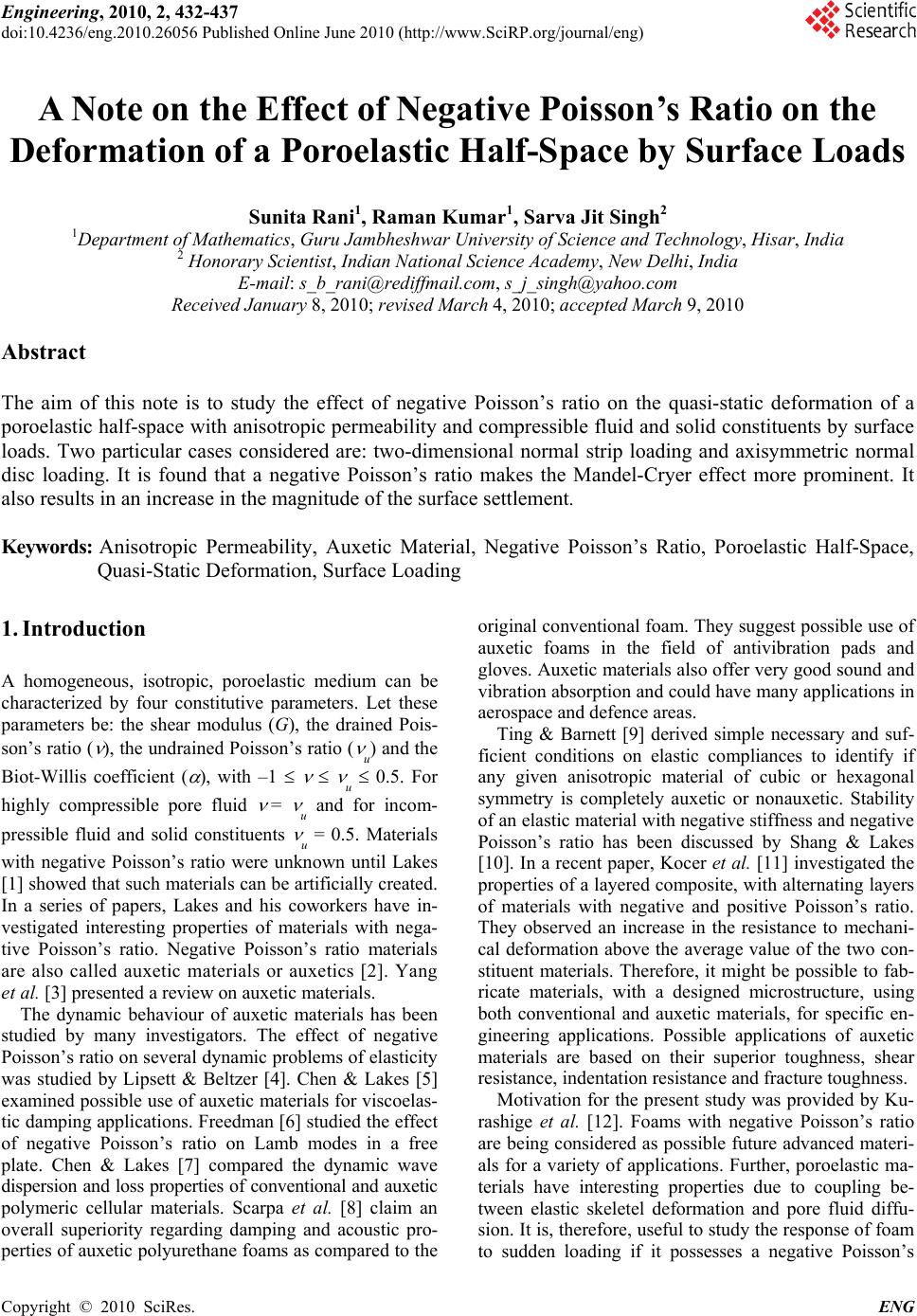 Engineering, 2010, 2, 432-437 doi:10.4236/eng.2010.26056 Published Online June 2010 (http://www.SciRP.org/journal/eng) Copyright © 2010 SciRes. ENG A Note on the Effect of Negative Poisson’s Ratio on the Deformation of a Poroelastic Half-Space by Surface Loads Sunita Rani1, Raman Kumar1, Sarva Jit Singh2 1Department of Mathematics, Guru Jambheshwar University of Science and Technology, Hisar, India 2 Honorary Scientist, Indian National Science Academy, New Delhi, India E-mail: s_b_rani@rediffmail.com, s_j_singh@yahoo.com Received January 8, 2010; revised March 4, 2010; accepted March 9, 2010 Abstract The aim of this note is to study the effect of negative Poisson’s ratio on the quasi-static deformation of a poroelastic half-space with anisotropic permeability and compressible fluid and solid constituents by surface loads. Two particular cases considered are: two-dimensional normal strip loading and axisymmetric normal disc loading. It is found that a negative Poisson’s ratio makes the Mandel-Cryer effect more prominent. It also results in an increase in the magnitude of the surface settlement. Keywords: Anisotropic Permeability, Auxetic Material, Negative Poisson’s Ratio, Poroelastic Half-Space, Quasi-Static Deformation, Surface Loading 1. Introduction A homogeneous, isotropic, poroelastic medium can be characterized by four constitutive parameters. Let these parameters be: the shear modulus (G), the drained Pois- son’s ratio ( ), the undrained Poisson’s ratio ( u) and the Biot-Willis coefficient ( ), with –1 u 0.5. For highly compressible pore fluid = u and for incom- pressible fluid and solid constituents u = 0.5. Materials with negative Poisson’s ratio were unknown until Lakes [1] showed that such materials can be artificially created. In a series of papers, Lakes and his coworkers have in- vestigated interesting properties of materials with nega- tive Poisson’s ratio. Negative Poisson’s ratio materials are also called auxetic materials or auxetics [2]. Yang et al. [3] presented a review on auxetic materials. The dynamic behaviour of auxetic materials has been studied by many investigators. The effect of negative Poisson’s ratio on several dynamic problems of elasticity was studied by Lipsett & Beltzer [4]. Chen & Lakes [5] examined possible use of auxetic materials for viscoelas- tic damping applications. Freedman [6] studied the effect of negative Poisson’s ratio on Lamb modes in a free plate. Chen & Lakes [7] compared the dynamic wave dispersion and loss properties of conventional and auxetic polymeric cellular materials. Scarpa et al. [8] claim an overall superiority regarding damping and acoustic pro- perties of auxetic polyurethane foams as compared to the original conventional foam. They suggest possible use of auxetic foams in the field of antivibration pads and gloves. Auxetic materials also offer very good sound and vibration absorption and could have many applications in aerospace and defence areas. Ting & Barnett [9] derived simple necessary and suf- ficient conditions on elastic compliances to identify if any given anisotropic material of cubic or hexagonal symmetry is completely auxetic or nonauxetic. Stability of an elastic material with negative stiffness and negative Poisson’s ratio has been discussed by Shang & Lakes [10]. In a recent paper, Kocer et al. [11] investigated the properties of a layered composite, with alternating layers of materials with negative and positive Poisson’s ratio. They observed an increase in the resistance to mechani- cal deformation above the average value of the two con- stituent materials. Therefore, it might be possible to fab- ricate materials, with a designed microstructure, using both conventional and auxetic materials, for specific en- gineering applications. Possible applications of auxetic materials are based on their superior toughness, shear resistance, indentation resistance and fracture toughness. Motivation for the present study was provided by Ku- rashige et al. [12]. Foams with negative Poisson’s ratio are being considered as possible future advanced materi- als for a variety of applications. Further, poroelastic ma- terials have interesting properties due to coupling be- tween elastic skeletel deformation and pore fluid diffu- sion. It is, therefore, useful to study the response of foam to sudden loading if it possesses a negative Poisson’s 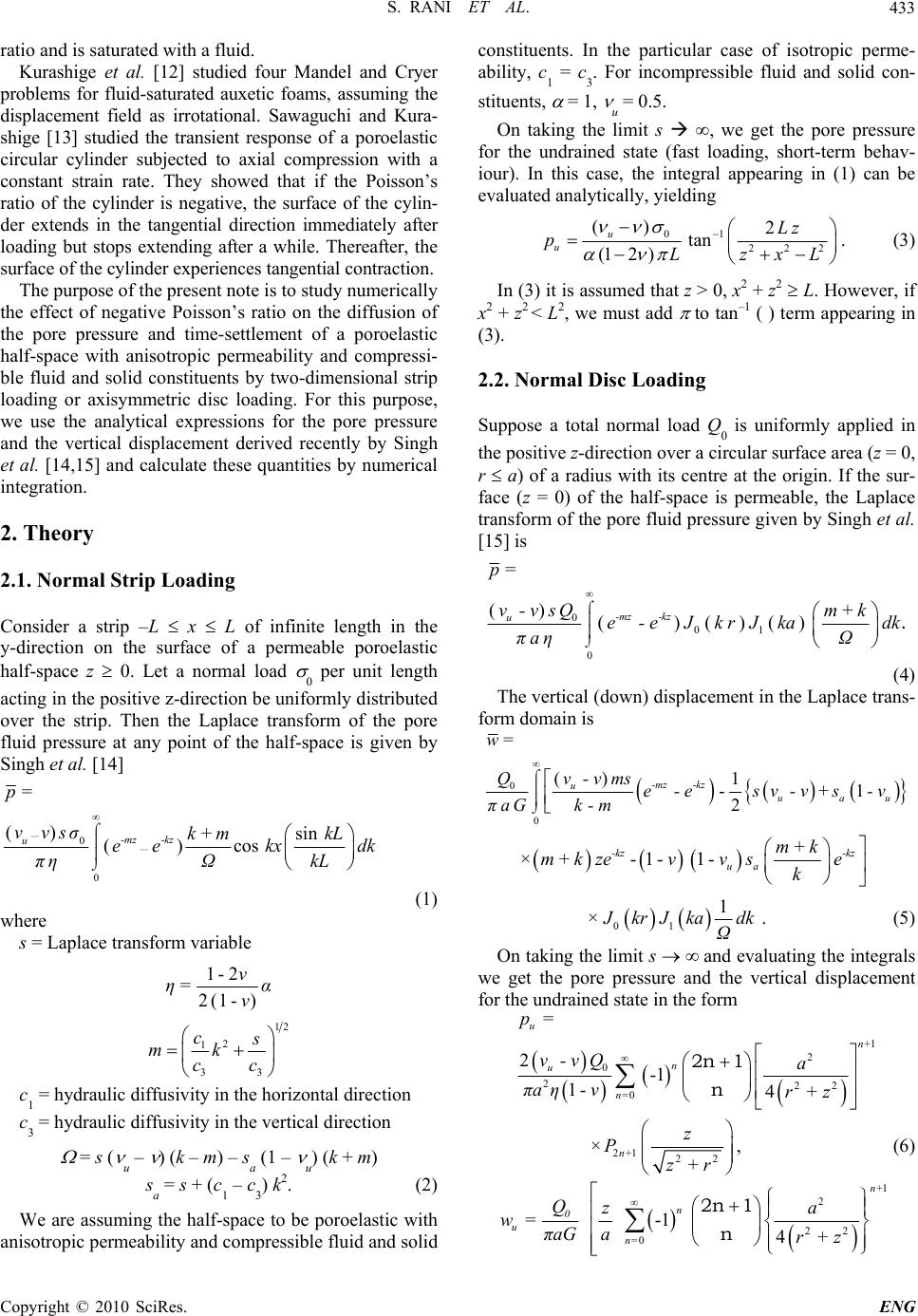 S. RANI ET AL.433 ratio and is saturated with a fluid. Kurashige et al. [12] studied four Mandel and Cryer problems for fluid-saturated auxetic foams, assuming the displacement field as irrotational. Sawaguchi and Kura- shige [13] studied the transient response of a poroelastic circular cylinder subjected to axial compression with a constant strain rate. They showed that if the Poisson’s ratio of the cylinder is negative, the surface of the cylin- der extends in the tangential direction immediately after loading but stops extending after a while. Thereafter, the surface of the cylinder experiences tangential contraction. The purpose of the present note is to study numerically the effect of negative Poisson’s ratio on the diffusion of the pore pressure and time-settlement of a poroelastic half-space with anisotropic permeability and compressi- ble fluid and solid constituents by two-dimensional strip loading or axisymmetric disc loading. For this purpose, we use the analytical expressions for the pore pressure and the vertical displacement derived recently by Singh et al. [14,15] and calculate these quantities by numerical integration. 2. Theory 2.1. Normal Strip Loading Consider a strip –L x L of infinite length in the y-direction on the surface of a permeable poroelastic half-space z 0. Let a normal load 0 per unit length acting in the positive z-direction be uniformly distributed over the strip. Then the Laplace transform of the pore fluid pressure at any point of the half-space is given by Singh et al. [14] 0 0 = () sin ()cos — — -mz -kz u p ννsσk+m kL eekx d πηΩ kL k (1) where s = Laplace transform variable 1-2 =2(1- ) ν ηα ν 12 2 1 33 cs mk cc c1 = hydraulic diffusivity in the horizontal direction c3 = hydraulic diffusivity in the vertical direction = s ( u – ) (k – m) – sa (1 – u) (k + m) sa = s + (c1 – c3) k2. (2) We are assuming the half-space to be poroelastic with anisotropic permeability and compressible fluid and solid constituents. In the particular case of isotropic perme- ability, c1 = c3. For incompressible fluid and solid con- stituents, = 1, u = 0.5. On taking the limit s , we get the pore pressure for the undrained state (fast loading, short-term behav- iour). In this case, the integral appearing in (1) can be evaluated analytically, yielding 1 0 222 () 2 tan (12 ) u u Lz pLzxL . (3) In (3) it is assumed that z > 0, x2 + z2 L. However, if x2 + z2 < L2, we must add to tan–1 ( ) term appearing in (3). 2.2. Normal Disc Loading Suppose a total normal load Q0 is uniformly applied in the positive z-direction over a circular surface area (z = 0, r a) of a radius with its centre at the origin. If the sur- face (z = 0) of the half-space is permeable, the Laplace transform of the pore fluid pressure given by Singh et al. [15] is 0 01 0 = () ()()() . -mz -kz u p ν-νsQ m+k e-e JkrJkadk πaηΩ (4) The vertical (down) displacement in the Laplace trans- form domain is 0 0 () 1 -1 2 -mz -kz u uau w= Qν-νms e-e sν-ν+s -ν πaGk -m ×-1-1- -kz -kz ua m+k m+k zeννse k 01 1 ×. J kr Jkadk Ω (5) On taking the limit s and evaluating the integrals we get the pore pressure and the vertical displacement for the undrained state in the form +1 2 0 222 =0 = 2-1 1- 4+ 2n 1 n u n n u n p ν-νQa πaην rz 2+1 22 × + n z P zr , (6) +1 2 22 =0 =-1 4+ 2n 1 n n n 0 u n Qza wπaG arz Copyright © 2010 SciRes. ENG 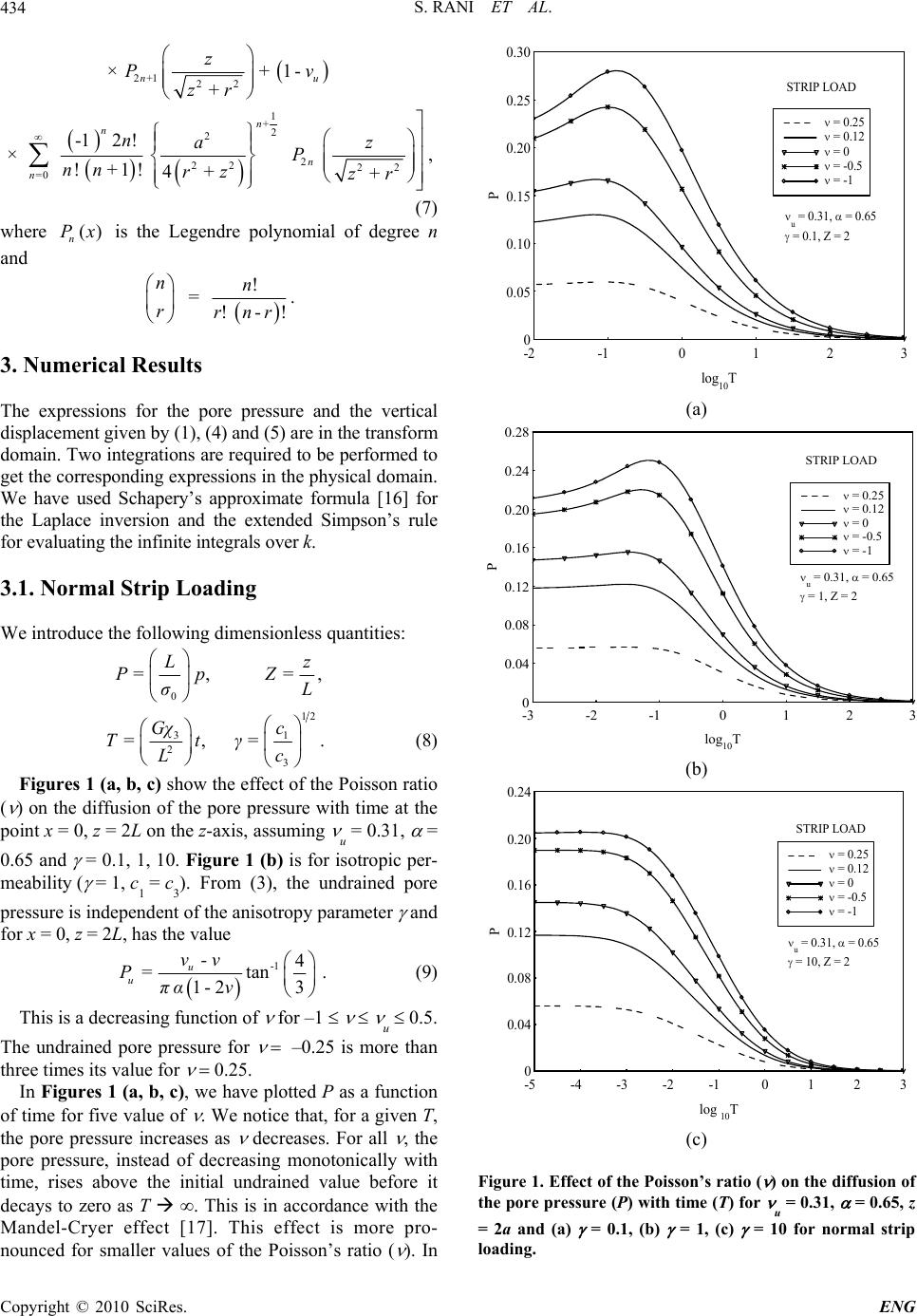 S. RANI ET AL. Copyright © 2010 SciRes. ENG 434 2+1 22 ×+ + nu z Pν zr 1- 1 +2 2 2 22 22 =0 -12 ! ×!+1! 4+ + n n n n naz P nn rz zr , (7) where is the Legendre polynomial of degree n and () n Px n r = ! !- n rnr! . 3. Numerical Results The expressions for the pore pressure and the vertical displacement given by (1), (4) and (5) are in the transform domain. Two integrations are required to be performed to get the corresponding expressions in the physical domain. We have used Schapery’s approximate formula [16] for the Laplace inversion and the extended Simpson’s rule for evaluating the infinite integrals over k. 3.1. Normal Strip Loading We introduce the following dimensionless quantities: 0 =, = Lz PpZ σL, 12 31 2 3 =,=. (8) Gχc Ttγc L Figures 1 (a, b, c) show the effect of the Poisson ratio ( ) on the diffusion of the pore pressure with time at the point x = 0, z = 2L on the z-axis, assuming u = 0.31, = 0.65 and = 0.1, 1, 10. Figure 1 (b) is for isotropic per- meability ( = 1, c1 = c3). From (3), the undrained pore pressure is independent of the anisotropy parameter and for x = 0, z = 2L, has the value -1 4 =tan 1-23 u u ν-ν Pπα ν. (9) This is a decreasing function of for –1 u 0.5. The undrained pore pressure for –0.25 is more than three times its value for 0.25. In Figures 1 (a, b, c), we have plotted P as a function of time for five value of . We notice that, for a given T, the pore pressure increases as decreases. For all , the pore pressure, instead of decreasing monotonically with time, rises above the initial undrained value before it decays to zero as T . This is in accordance with the Mandel-Cryer effect [17]. This effect is more pro- nounced for smaller values of the Poisson’s ratio ( ). In 0 0.05 0.10 0.15 0.20 0.25 0.30 -2 -10 1 2 3 = 0.25 = 0.12 = 0 = -0.5 = -1 STRIP LOAD u = 0.31, = 0.65 = 0.1, Z = 2 log10T P (a) 0 0.04 0.08 0.12 0.16 0.20 0.24 0.28 -3 -2 -1 0 1 2 3 = 0.25 = 0.12 = 0 = -0.5 = -1 u = 0.31, = 0.65 = 1, Z = 2 STRIP LOAD log 10 T P (b) 0 0.04 0.08 0.12 0.16 0.20 0.24 -5 -4 -3-2 -1 0 1 2 3 = 0.25 = 0.12 = 0 = -0.5 = -1 u = 0.31, = 0.65 = 10, Z = 2 STRIP LOAD log 10T P (c) Figure 1. Effect of the Poisson’s ratio ( ) on the diffusion of the pore pressure (P) with time (T) for u = 0.31, = 0.65, z = 2a and (a) = 0.1, (b) = 1, (c) = 10 for normal strip loading. 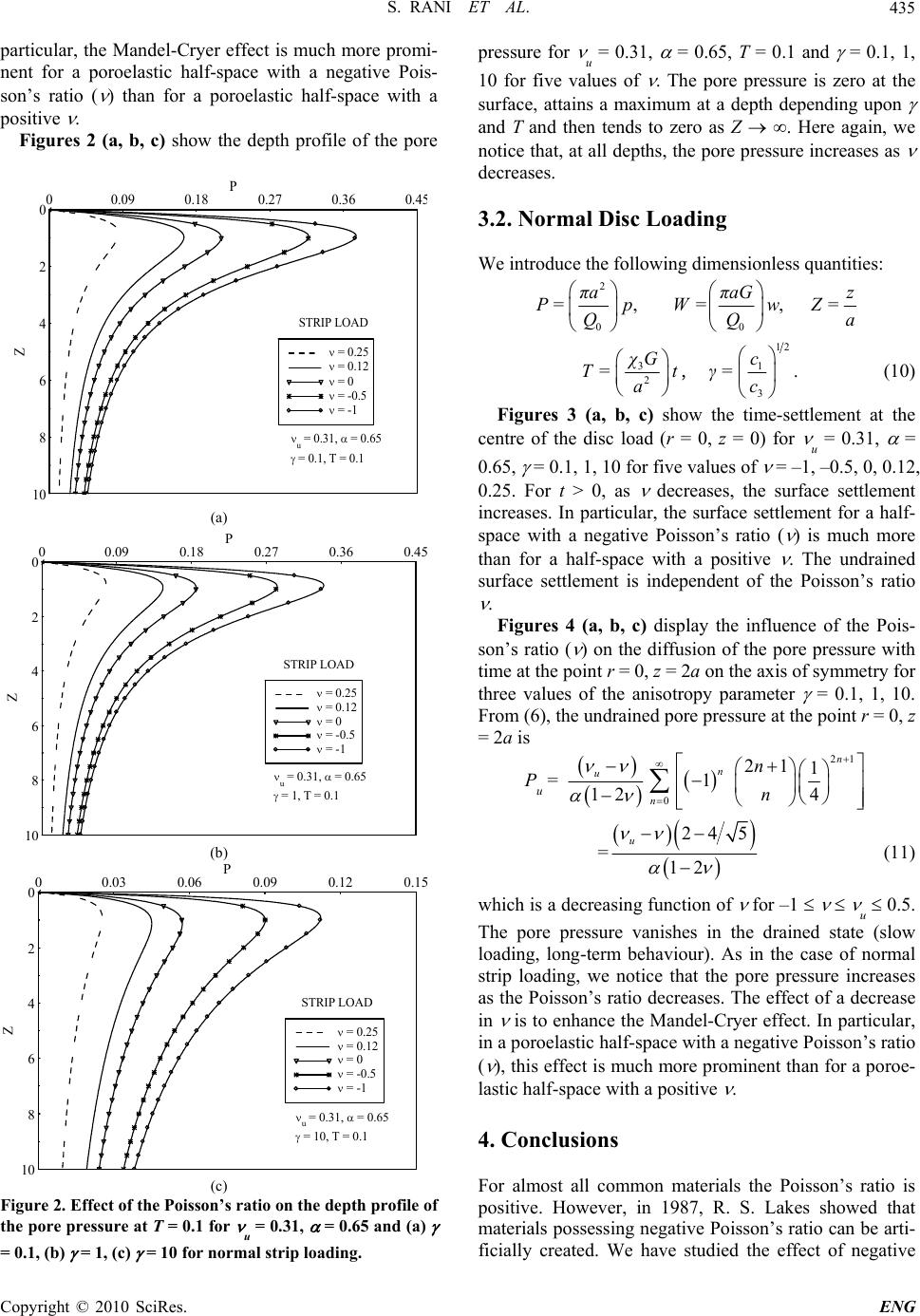 S. RANI ET AL.435 particular, the Mandel-Cryer effect is much more promi- nent for a poroelastic half-space with a negative Pois- son’s ratio ( ) than for a poroelastic half-space with a positive . Figures 2 (a, b, c) show the depth profile of the pore 0 2 4 6 8 10 00.09 0.18 0.27 0.36 0.4 5 = 0.25 = 0.12 = 0 = -0.5 = -1 u = 0.31, = 0.65 = 0.1, T = 0.1 STRIP LOAD Z P (a) 0 2 4 6 8 10 00.09 0.18 0.27 0.36 0.45 = 0.25 = 0.12 = 0 = -0.5 = -1 u = 0.31, = 0.65 = 1, T = 0.1 STRIP LOAD Z P (b) 0 2 4 6 8 10 00.03 0.06 0.09 0.12 0.15 = 0.25 = 0.12 = 0 = -0.5 = -1 u = 0.31, = 0.65 = 10, T = 0.1 STRIP LOAD Z P (c) Figure 2. Effect of the Poisson’s ratio on the depth profile of the pore pressure at T = 0.1 for u = 0.31, = 0.65 and (a) = 0.1, (b) = 1, (c) = 10 for normal strip loading. pressure for u = 0.31, = 0.65, T = 0.1 and = 0.1, 1, 10 for five values of . The pore pressure is zero at the surface, attains a maximum at a depth depending upon and T and then tends to zero as Z ∞. Here again, we notice that, at all depths, the pore pressure increases as decreases. 3.2. Normal Disc Loading We introduce the following dimensionless quantities: 2 00 =,= , πaπaG z PpWwZ QQ = a 12 31 2 3 = χGc T=t γc a ,. (10) Figures 3 (a, b, c) show the time-settlement at the centre of the disc load (r = 0, z = 0) for u = 0.31, = 0.65, = 0.1, 1, 10 for five values of = –1, –0.5, 0, 0.12, 0.25. For t > 0, as decreases, the surface settlement increases. In particular, the surface settlement for a half- space with a negative Poisson’s ratio ( ) is much more than for a half-space with a positive . The undrained surface settlement is independent of the Poisson’s ratio . Figures 4 (a, b, c) display the influence of the Pois- son’s ratio ( ) on the diffusion of the pore pressure with time at the point r = 0, z = 2a on the axis of symmetry for three values of the anisotropy parameter = 0.1, 1, 10. From (6), the undrained pore pressure at the point r = 0, z = 2a is Pu = 21 0 21 1 1 12 4 n n u n n n = 24 5 12 u (11) which is a decreasing function of for –1 u 0.5. The pore pressure vanishes in the drained state (slow loading, long-term behaviour). As in the case of normal strip loading, we notice that the pore pressure increases as the Poisson’s ratio decreases. The effect of a decrease in is to enhance the Mandel-Cryer effect. In particular, in a poroelastic half-space with a negative Poisson’s ratio ( ), this effect is much more prominent than for a poroe- lastic half-space with a positive . 4. Conclusions For almost all common materials the Poisson’s ratio is positive. However, in 1987, R. S. Lakes showed that materials possessing negative Poisson’s ratio can be arti- ficially created. We have studied the effect of negative Copyright © 2010 SciRes. ENG 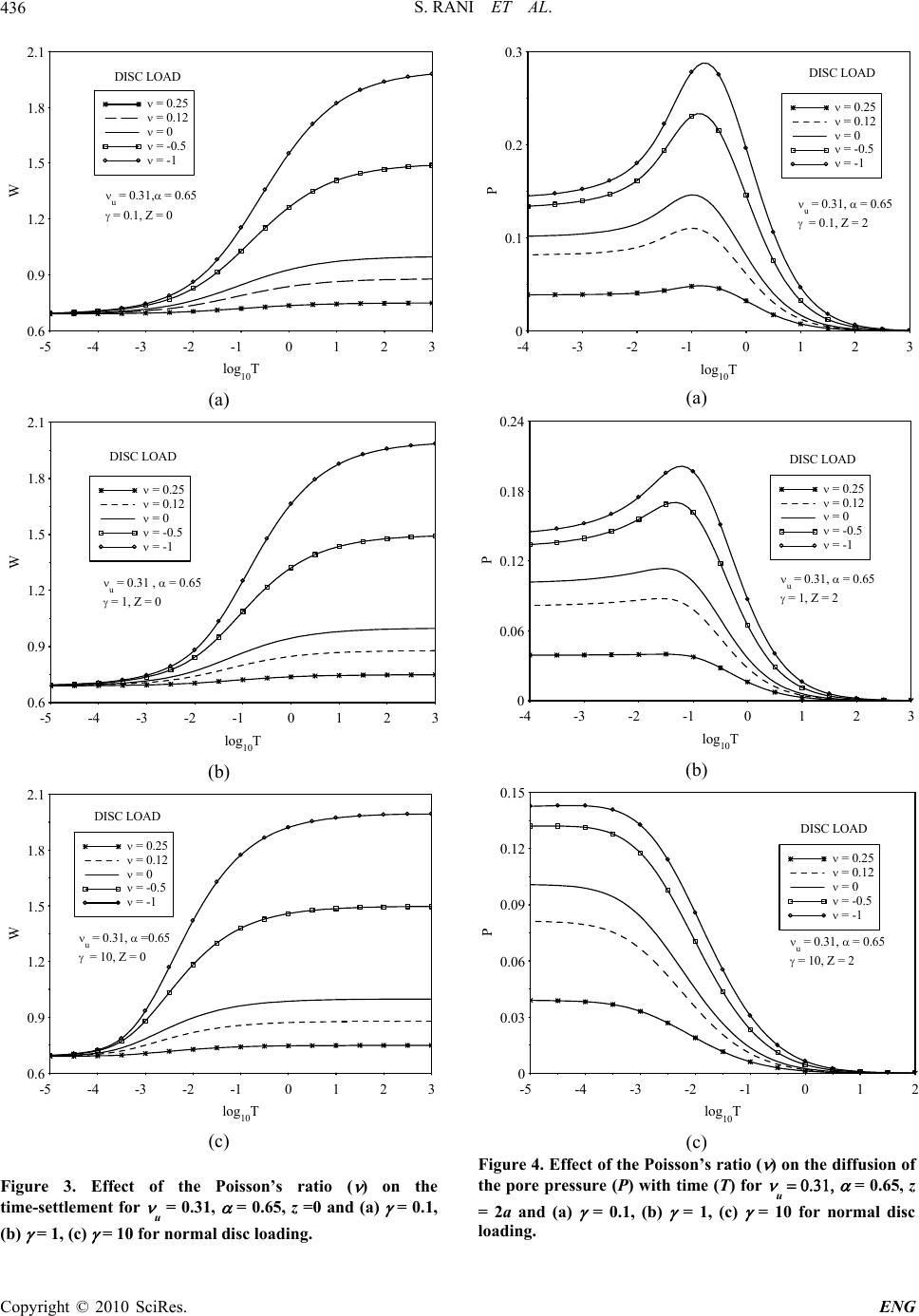 S. RANI ET AL. Copyright © 2010 SciRes. ENG 436 0.6 0.9 1.2 1.5 1.8 2.1 -5 -4 -3 -2 -10123 = 0.25 = 0.12 = 0 = -0.5 = -1 DISC LOAD u = 0.31, = 0.65 = 0.1, Z = 0 log 10 T W (a) 0.6 0.9 1.2 1.5 1.8 2.1 -5 -4-3 -2-10123 = 0.25 = 0.12 = 0 = -0.5 = -1 DISC LOAD u = 0.31 , = 0.65 = 1, Z = 0 log 10 T W (b) 0.6 0.9 1.2 1.5 1.8 2.1 -5 -4 -3 -2 -1 0 12 3 = 0.25 = 0.12 = 0 = -0.5 = -1 DISC LOAD u = 0.31, =0.65 = 10, Z = 0 log 10 T W (c) Figure 3. Effect of the Poisson’s ratio ( ) on the time-settlement for u = 0.31, = 0.65, z =0 and (a) = 0.1, (b) = 1, (c) = 10 for normal disc loading. 0 0.1 0.2 0.3 -4 -3 -2 -10 1 2 3 = 0.25 = 0.12 = 0 = -0.5 = -1 DISC LOAD u = 0.31, = 0.65 = 0.1, Z = 2 log 10 T P (a) 0 0.06 0.12 0.18 0.24 -4 -3 -2 -1 0 1 2 3 = 0.25 = 0.12 = 0 = -0.5 = -1 DISC LOAD u = 0.31, = 0.65 = 1, Z = 2 log 10 T P (b) 0 0.03 0.06 0.09 0.12 0.15 -5 -4 -3-2-10 1 2 = 0.25 = 0.12 = 0 = -0.5 = -1 DISC LOAD u = 0.31, = 0.65 = 10, Z = 2 log 10 T P (c) Figure 4. Effect of the Poisson’s ratio ( ) on the diffusion of the pore pressure (P) with time (T) for u = 0.65, z = 2a and (a) = 0.1, (b) = 1, (c) = 10 for normal disc loading. 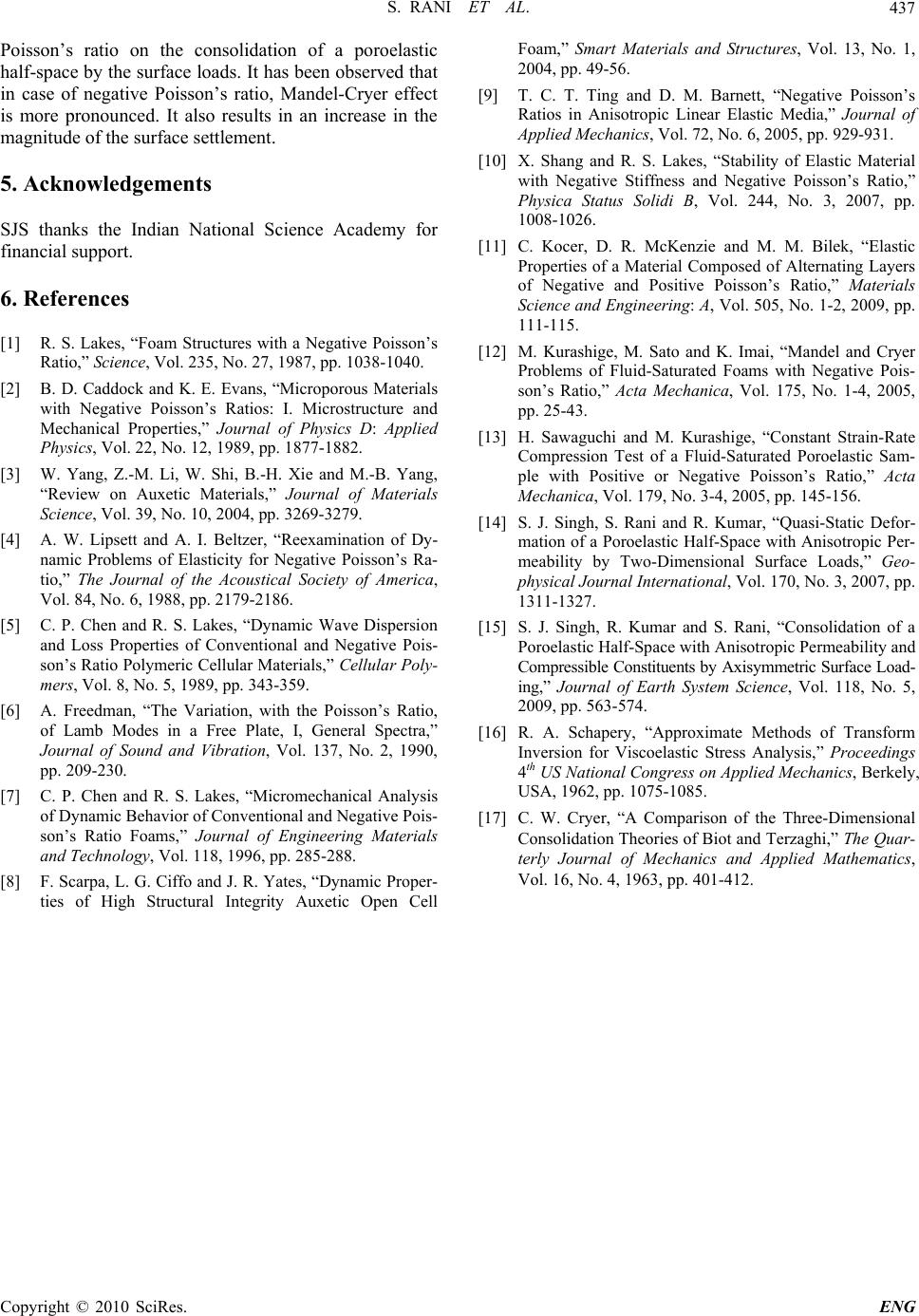 S. RANI ET AL. Copyright © 2010 SciRes. ENG 437 Poisson’s ratio on the consolidation of a poroelastic half-space by the surface loads. It has been observed that in case of negative Poisson’s ratio, Mandel-Cryer effect is more pronounced. It also results in an increase in the magnitude of the surface settlement. 5. Acknowledgements SJS thanks the Indian National Science Academy for financial support. 6 . References [1] R. S. Lakes, “Foam Structures with a Negative Poisson’s Ratio,” Science, Vol. 235, No. 27, 1987, pp. 1038-1040. [2] B. D. Caddock and K. E. Evans, “Microporous Materials with Negative Poisson’s Ratios: I. Microstructure and Mechanical Properties,” Journal of Physics D: Applied Physics, Vol. 22, No. 12, 1989, pp. 1877-1882. [3] W. Yang, Z.-M. Li, W. Shi, B.-H. Xie and M.-B. Yang, “Review on Auxetic Materials,” Journal of Materials Science, Vol. 39, No. 10, 2004, pp. 3269-3279. [4] A. W. Lipsett and A. I. Beltzer, “Reexamination of Dy- namic Problems of Elasticity for Negative Poisson’s Ra- tio,” The Journal of the Acoustical Society of America, Vol. 84, No. 6, 1988, pp. 2179-2186. [5] C. P. Chen and R. S. Lakes, “Dynamic Wave Dispersion and Loss Properties of Conventional and Negative Pois- son’s Ratio Polymeric Cellular Materials,” Cellular Poly- mers, Vol. 8, No. 5, 1989, pp. 343-359. [6] A. Freedman, “The Variation, with the Poisson’s Ratio, of Lamb Modes in a Free Plate, I, General Spectra,” Journal of Sound and Vibration, Vol. 137, No. 2, 1990, pp. 209-230. [7] C. P. Chen and R. S. Lakes, “Micromechanical Analysis of Dynamic Behavior of Conventional and Negative Pois- son’s Ratio Foams,” Journal of Engineering Materials and Technology, Vol. 118, 1996, pp. 285-288. [8] F. Scarpa, L. G. Ciffo and J. R. Yates, “Dynamic Proper- ties of High Structural Integrity Auxetic Open Cell Foam,” Smart Materials and Structures, Vol. 13, No. 1, 2004, pp. 49-56. [9] T. C. T. Ting and D. M. Barnett, “Negative Poisson’s Ratios in Anisotropic Linear Elastic Media,” Journal of Applied Mechanics, Vol. 72, No. 6, 2005, pp. 929-931. [10] X. Shang and R. S. Lakes, “Stability of Elastic Material with Negative Stiffness and Negative Poisson’s Ratio,” Physica Status Solidi B, Vol. 244, No. 3, 2007, pp. 1008-1026. [11] C. Kocer, D. R. McKenzie and M. M. Bilek, “Elastic Properties of a Material Composed of Alternating Layers of Negative and Positive Poisson’s Ratio,” Materials Science and Engineering: A, Vol. 505, No. 1-2, 2009, pp. 111-115. [12] M. Kurashige, M. Sato and K. Imai, “Mandel and Cryer Problems of Fluid-Saturated Foams with Negative Pois- son’s Ratio,” Acta Mechanica, Vol. 175, No. 1-4, 2005, pp. 25-43. [13] H. Sawaguchi and M. Kurashige, “Constant Strain-Rate Compression Test of a Fluid-Saturated Poroelastic Sam- ple with Positive or Negative Poisson’s Ratio,” Acta Mechanica, Vol. 179, No. 3-4, 2005, pp. 145-156. [14] S. J. Singh, S. Rani and R. Kumar, “Quasi-Static Defor- mation of a Poroelastic Half-Space with Anisotropic Per- meability by Two-Dimensional Surface Loads,” Geo- physical Journal International, Vol. 170, No. 3, 2007, pp. 1311-1327. [15] S. J. Singh, R. Kumar and S. Rani, “Consolidation of a Poroelastic Half-Space with Anisotropic Permeability and Compressible Constituents by Axisymmetric Surface Load- ing,” Journal of Earth System Science, Vol. 118, No. 5, 2009, pp. 563-574. [16] R. A. Schapery, “Approximate Methods of Transform Inversion for Viscoelastic Stress Analysis,” Proceedings 4th US National Congress on Applied Mechanics, Berkely, USA, 1962, pp. 1075-1085. [17] C. W. Cryer, “A Comparison of the Three-Dimensional Consolidation Theories of Biot and Terzaghi,” The Quar- terly Journal of Mechanics and Applied Mathematics, Vol. 16, No. 4, 1963, pp. 401-412. |

